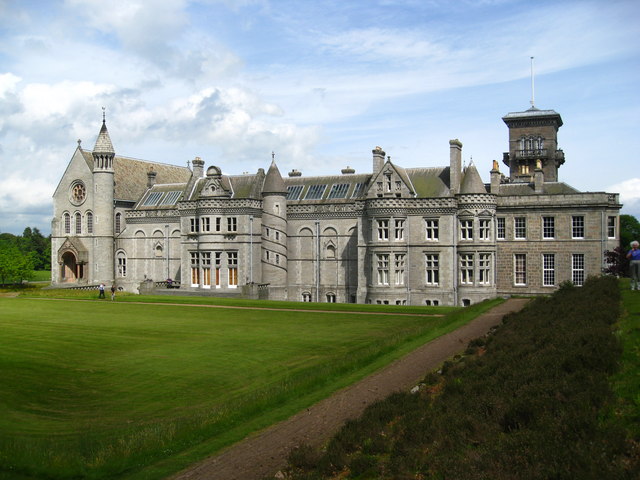Wikimedia Commons Dunecht House is a stately home on the Dunecht estate in Aberdeenshire, Scotland. The house is protected as a category A listed building, and the grounds are included on the Inventory of Gardens and Designed Landscapes in Scotland, the national listing of significant gardens.
The original house was built in 1705 but it was replaced by William Forbes in 1820 when he commissioned John Smith John Smith (1781 – 22 July 1852) was a Scottish architect who contributed significantly to the architecture of Aberdeen.
The body of Alexander Lindsay, 25th Earl of Crawford, who died in 1880, was stolen from a vault in the private chapel in 1881. The theft was not discovered until a letter was received several months later providing the information. Extensive searches were carried out and it was eventually located in July 1882; it was later transported to Haigh Hall Historic country house in Haigh, near Wigan in Greater Manchester England.
Unoccupied from 1998 until 2012 while it was in the ownership of Charles Anthony Pearson, brother of the 4th Viscount Cowdray, it was purchased in 2012 by Aberdeen businessman Jamie Oag.
The barony of Echt had been owned by the Forbes family since 1469 and the original mansion house, built in 1705, was known as Housedale. The present mansion is located slightly to the south west of it.[1] [2] [3] [4] [3] [5] [6]
Usually an annual ball was held at either Haigh Hall or the family’s London home but in October 1871 it was hosted at Dunecht. Attendees included the Gordons from Cluny Castle Originally built in about 1604 as a Z-plan castle, replacing either a house or small peel tower. Sited in the parish of Cluny, it is south of Monymusk and north of Sauchen in Aberdeenshire, north-east Scotland. Forglen House Mansion house that forms the centrepiece of the Forglen estate in the parish of Forglen, northwest of Turriff, Aberdeenshire, in the northeast of Scotland. [7]
Additional internal renovations were commissioned around 1867 and undertaken by George Edmund Street.[8] [9]
Alexander Lindsay, 25th Earl of Crawford died in 1880 and his body was stolen in 1881.[8] [10] [11] [12]
The estate was offered for sale in 1886 but remained unsold[8] [13] [8] [14] [8]
It also has an observatory, built by James Ludovic Lindsay, the 26th Earl of Crawford[15] [16]
The original design for the mansion by John Smith in 1820 was constructed from granite, had a full basement, three main reception rooms.[1]
Initial extensions designed by Smith’s son built out to the west of the existing house. These incorporated a prominent Italianate tower in the style of Osborne House and canted bays on two gables. Large reception rooms were housed within these. The earlier part of the mansion had a new galleried staircase as well as other refurbishments made to it. A galleried staircase was added to the original part of the mansion and a porte-cochère From the French meaning "coach door", also known as a coach gate or carriage porch, a covered porch-like structure at a main or secondary entrance to a building that gives access to a vehicle while providing arriving and departing occupants with protection from the elements. [3]
Like the mansion house,[8] [17] [18] [6]
The grounds are included on the Inventory of Gardens and Designed Landscapes in Scotland, the national listing of significant gardens.[19]
The house was owned by Charles Anthony Pearson, brother of the 4th Viscount Cowdray,[20] [21] [22] [23] [24]
{4928910:V2MEV59E};{4928910:CIA4PD8B};{4928910:V2MEV59E};{4928910:8A7JMZWP};{4928910:XPHPEZ8S};{4928910:6FEDCQN6};{4928910:7RKPSIF8};{4928910:IFT5NXGR};{4928910:CD3CEYQ4};{4928910:V6QUM7XH};{4928910:CNRLGXN2};{4928910:CNRLGXN2};{4928910:V2MEV59E};{4928910:4TFLT3EB};{4928910:BFEBJEXU};{4928910:C272XJ3T};{4928910:8ZJ3B4PC};{4928910:3IYL6I7P};{4928910:83NPBGPK};{4928910:X5BTUZJU};{4928910:494H2ADD};{4928910:I57D3WYS};{4928910:RKLC9WLU};{4928910:B8E38FNP}
modern-language-association
author
asc
no
1
4689
%7B%22status%22%3A%22success%22%2C%22updateneeded%22%3Afalse%2C%22instance%22%3A%22zotpress-b9b848f5423c1cc2190c8dd5539d067f%22%2C%22meta%22%3A%7B%22request_last%22%3A0%2C%22request_next%22%3A0%2C%22used_cache%22%3Atrue%7D%2C%22data%22%3A%5B%7B%22key%22%3A%22BFEBJEXU%22%2C%22library%22%3A%7B%22id%22%3A4928910%7D%2C%22meta%22%3A%7B%22creatorSummary%22%3A%22Ashcroft%22%2C%22parsedDate%22%3A%222009%22%2C%22numChildren%22%3A0%7D%2C%22bib%22%3A%22%3Cdiv%20class%3D%5C%22csl-bib-body%5C%22%20style%3D%5C%22line-height%3A%202%3B%20padding-left%3A%201em%3B%20text-indent%3A-1em%3B%5C%22%3E%5Cn%20%20%3Cdiv%20class%3D%5C%22csl-entry%5C%22%3EAshcroft%2C%20Tony.%20%3Ci%3ECrowned%20with%20the%20Stars%3C%5C%2Fi%3E.%20WLCT%2C%202009%2C%20%3Ca%20target%3D%27_blank%27%20href%3D%27http%3A%5C%2F%5C%2Fissuu.com%5C%2Fwlct%5C%2Fdocs%5C%2Fpf51%5C%2F9%27%3Ehttp%3A%5C%2F%5C%2Fissuu.com%5C%2Fwlct%5C%2Fdocs%5C%2Fpf51%5C%2F9%3C%5C%2Fa%3E.%3C%5C%2Fdiv%3E%5Cn%3C%5C%2Fdiv%3E%22%2C%22data%22%3A%7B%22itemType%22%3A%22book%22%2C%22title%22%3A%22Crowned%20with%20the%20stars%22%2C%22creators%22%3A%5B%7B%22creatorType%22%3A%22author%22%2C%22firstName%22%3A%22Tony%22%2C%22lastName%22%3A%22Ashcroft%22%7D%5D%2C%22abstractNote%22%3A%22%22%2C%22date%22%3A%222009%22%2C%22language%22%3A%22%22%2C%22ISBN%22%3A%22%22%2C%22url%22%3A%22http%3A%5C%2F%5C%2Fissuu.com%5C%2Fwlct%5C%2Fdocs%5C%2Fpf51%5C%2F9%22%2C%22collections%22%3A%5B%22TX5P5MLX%22%5D%2C%22dateModified%22%3A%222018-08-11T14%3A42%3A37Z%22%7D%7D%2C%7B%22key%22%3A%22CIA4PD8B%22%2C%22library%22%3A%7B%22id%22%3A4928910%7D%2C%22meta%22%3A%7B%22creatorSummary%22%3A%22Canmore%22%2C%22numChildren%22%3A0%7D%2C%22bib%22%3A%22%3Cdiv%20class%3D%5C%22csl-bib-body%5C%22%20style%3D%5C%22line-height%3A%202%3B%20padding-left%3A%201em%3B%20text-indent%3A-1em%3B%5C%22%3E%5Cn%20%20%3Cdiv%20class%3D%5C%22csl-entry%5C%22%3ECanmore.%20%3Ci%3EDunecht%20House%2C%20Housedale%3C%5C%2Fi%3E.%20%3Ca%20target%3D%27_blank%27%20href%3D%27http%3A%5C%2F%5C%2Fcanmore.rcahms.gov.uk%5C%2Fen%5C%2Fsite%5C%2F18508%5C%2Fdetails%5C%2Fdunecht%20house%20housedale%5C%2F%27%3Ehttp%3A%5C%2F%5C%2Fcanmore.rcahms.gov.uk%5C%2Fen%5C%2Fsite%5C%2F18508%5C%2Fdetails%5C%2Fdunecht%20house%20housedale%5C%2F%3C%5C%2Fa%3E.%3C%5C%2Fdiv%3E%5Cn%3C%5C%2Fdiv%3E%22%2C%22data%22%3A%7B%22itemType%22%3A%22webpage%22%2C%22title%22%3A%22Dunecht%20House%2C%20Housedale%22%2C%22creators%22%3A%5B%7B%22creatorType%22%3A%22author%22%2C%22firstName%22%3A%22%22%2C%22lastName%22%3A%22Canmore%22%7D%5D%2C%22abstractNote%22%3A%22%22%2C%22date%22%3A%22%22%2C%22url%22%3A%22http%3A%5C%2F%5C%2Fcanmore.rcahms.gov.uk%5C%2Fen%5C%2Fsite%5C%2F18508%5C%2Fdetails%5C%2Fdunecht%20house%20housedale%5C%2F%22%2C%22language%22%3A%22%22%2C%22collections%22%3A%5B%22TX5P5MLX%22%5D%2C%22dateModified%22%3A%222018-08-11T14%3A52%3A46Z%22%7D%7D%2C%7B%22key%22%3A%22XPHPEZ8S%22%2C%22library%22%3A%7B%22id%22%3A4928910%7D%2C%22meta%22%3A%7B%22creatorSummary%22%3A%22Farrer%20and%20Brownbill%22%2C%22parsedDate%22%3A%221907%22%2C%22numChildren%22%3A0%7D%2C%22bib%22%3A%22%3Cdiv%20class%3D%5C%22csl-bib-body%5C%22%20style%3D%5C%22line-height%3A%202%3B%20padding-left%3A%201em%3B%20text-indent%3A-1em%3B%5C%22%3E%5Cn%20%20%3Cdiv%20class%3D%5C%22csl-entry%5C%22%3EFarrer%2C%20William%2C%20and%20J.%20Brownbill%2C%20editors.%20%26%23x201C%3BAtherton.%26%23x201D%3B%20%3Ci%3EA%20History%20of%20the%20County%20of%20Lancaster%2C%26%23xA0%3B%20Volume%203%3C%5C%2Fi%3E%2C%20Victoria%20County%20History%2C%201907%2C%20pp.%20435%26%23x2013%3B39%2C%20%3Ca%20target%3D%27_blank%27%20href%3D%27http%3A%5C%2F%5C%2Fwww.british-history.ac.uk%5C%2Freport.aspx%3Fcompid%3D41363%27%3Ehttp%3A%5C%2F%5C%2Fwww.british-history.ac.uk%5C%2Freport.aspx%3Fcompid%3D41363%3C%5C%2Fa%3E.%3C%5C%2Fdiv%3E%5Cn%3C%5C%2Fdiv%3E%22%2C%22data%22%3A%7B%22itemType%22%3A%22bookSection%22%2C%22title%22%3A%22Atherton%22%2C%22creators%22%3A%5B%7B%22creatorType%22%3A%22editor%22%2C%22firstName%22%3A%22William%22%2C%22lastName%22%3A%22Farrer%22%7D%2C%7B%22creatorType%22%3A%22editor%22%2C%22firstName%22%3A%22J%22%2C%22lastName%22%3A%22Brownbill%22%7D%5D%2C%22abstractNote%22%3A%22%22%2C%22bookTitle%22%3A%22A%20History%20of%20the%20County%20of%20Lancaster%2C%20%20Volume%203%22%2C%22date%22%3A%221907%22%2C%22language%22%3A%22%22%2C%22ISBN%22%3A%22%22%2C%22url%22%3A%22http%3A%5C%2F%5C%2Fwww.british-history.ac.uk%5C%2Freport.aspx%3Fcompid%3D41363%22%2C%22collections%22%3A%5B%228HTWT5B3%22%5D%2C%22dateModified%22%3A%222024-01-23T19%3A59%3A54Z%22%7D%7D%2C%7B%22key%22%3A%223IYL6I7P%22%2C%22library%22%3A%7B%22id%22%3A4928910%7D%2C%22meta%22%3A%7B%22creatorSummary%22%3A%22Historic%20Environment%20Scotland%22%2C%22numChildren%22%3A0%7D%2C%22bib%22%3A%22%3Cdiv%20class%3D%5C%22csl-bib-body%5C%22%20style%3D%5C%22line-height%3A%202%3B%20padding-left%3A%201em%3B%20text-indent%3A-1em%3B%5C%22%3E%5Cn%20%20%3Cdiv%20class%3D%5C%22csl-entry%5C%22%3EHistoric%20Environment%20Scotland.%20%3Ci%3EHS%20Search%20Results%3C%5C%2Fi%3E.%20%3Ca%20target%3D%27_blank%27%20href%3D%27http%3A%5C%2F%5C%2Fportal.historicenvironment.scot%5C%2Fhes%5C%2Fweb%5C%2Ff%3Fp%3D1505%3A200%3A%3A%3ANO%3ARP%3ASEARCH_UNDERWAY%3A1%27%3Ehttp%3A%5C%2F%5C%2Fportal.historicenvironment.scot%5C%2Fhes%5C%2Fweb%5C%2Ff%3Fp%3D1505%3A200%3A%3A%3ANO%3ARP%3ASEARCH_UNDERWAY%3A1%3C%5C%2Fa%3E.%3C%5C%2Fdiv%3E%5Cn%3C%5C%2Fdiv%3E%22%2C%22data%22%3A%7B%22itemType%22%3A%22webpage%22%2C%22title%22%3A%22HS%20search%20results%22%2C%22creators%22%3A%5B%7B%22creatorType%22%3A%22author%22%2C%22firstName%22%3A%22%22%2C%22lastName%22%3A%22Historic%20Environment%20Scotland%22%7D%5D%2C%22abstractNote%22%3A%22%22%2C%22date%22%3A%22%22%2C%22url%22%3A%22http%3A%5C%2F%5C%2Fportal.historicenvironment.scot%5C%2Fhes%5C%2Fweb%5C%2Ff%3Fp%3D1505%3A200%3A%3A%3ANO%3ARP%3ASEARCH_UNDERWAY%3A1%22%2C%22language%22%3A%22%22%2C%22collections%22%3A%5B%22TX5P5MLX%22%5D%2C%22dateModified%22%3A%222018-08-11T14%3A50%3A28Z%22%7D%7D%2C%7B%22key%22%3A%22IFT5NXGR%22%2C%22library%22%3A%7B%22id%22%3A4928910%7D%2C%22meta%22%3A%7B%22creatorSummary%22%3A%22Historic%20Environment%20Scotland%22%2C%22numChildren%22%3A0%7D%2C%22bib%22%3A%22%3Cdiv%20class%3D%5C%22csl-bib-body%5C%22%20style%3D%5C%22line-height%3A%202%3B%20padding-left%3A%201em%3B%20text-indent%3A-1em%3B%5C%22%3E%5Cn%20%20%3Cdiv%20class%3D%5C%22csl-entry%5C%22%3EHistoric%20Environment%20Scotland.%20%3Ci%3EDunecht%20House%3A%20Listed%20Building%20Report%3C%5C%2Fi%3E.%20%3Ca%20target%3D%27_blank%27%20href%3D%27http%3A%5C%2F%5C%2Fdata.historic-scotland.gov.uk%5C%2Fpls%5C%2Fhtmldb%5C%2Ff%3Fp%3D2200%3A15%3A0%3A%3A%3A%3ABUILDING%2CHL%3A3133%2CDunecht%2520House%27%3Ehttp%3A%5C%2F%5C%2Fdata.historic-scotland.gov.uk%5C%2Fpls%5C%2Fhtmldb%5C%2Ff%3Fp%3D2200%3A15%3A0%3A%3A%3A%3ABUILDING%2CHL%3A3133%2CDunecht%2520House%3C%5C%2Fa%3E.%3C%5C%2Fdiv%3E%5Cn%3C%5C%2Fdiv%3E%22%2C%22data%22%3A%7B%22itemType%22%3A%22webpage%22%2C%22title%22%3A%22Dunecht%20House%3A%20Listed%20Building%20Report%22%2C%22creators%22%3A%5B%7B%22creatorType%22%3A%22author%22%2C%22firstName%22%3A%22%22%2C%22lastName%22%3A%22Historic%20Environment%20Scotland%22%7D%5D%2C%22abstractNote%22%3A%22%22%2C%22date%22%3A%22%22%2C%22url%22%3A%22http%3A%5C%2F%5C%2Fdata.historic-scotland.gov.uk%5C%2Fpls%5C%2Fhtmldb%5C%2Ff%3Fp%3D2200%3A15%3A0%3A%3A%3A%3ABUILDING%2CHL%3A3133%2CDunecht%2520House%22%2C%22language%22%3A%22%22%2C%22collections%22%3A%5B%22TX5P5MLX%22%5D%2C%22dateModified%22%3A%222018-08-11T14%3A59%3A20Z%22%7D%7D%2C%7B%22key%22%3A%228ZJ3B4PC%22%2C%22library%22%3A%7B%22id%22%3A4928910%7D%2C%22meta%22%3A%7B%22creatorSummary%22%3A%22Historic%20Scotland%22%2C%22numChildren%22%3A0%7D%2C%22bib%22%3A%22%3Cdiv%20class%3D%5C%22csl-bib-body%5C%22%20style%3D%5C%22line-height%3A%202%3B%20padding-left%3A%201em%3B%20text-indent%3A-1em%3B%5C%22%3E%5Cn%20%20%3Cdiv%20class%3D%5C%22csl-entry%5C%22%3EHistoric%20Scotland.%20%3Ci%3ETower%20Lodges%20and%20Gates%2C%20Ref%3A%2016505%3C%5C%2Fi%3E.%20%3Ca%20target%3D%27_blank%27%20href%3D%27http%3A%5C%2F%5C%2Fdata.historic-scotland.gov.uk%5C%2Fpls%5C%2Fhtmldb%5C%2Ff%3Fp%3D2200%3A15%3A0%3A%3A%3A%3ABUILDING%2CHL%3A16505%2CDunecht%2520House%27%3Ehttp%3A%5C%2F%5C%2Fdata.historic-scotland.gov.uk%5C%2Fpls%5C%2Fhtmldb%5C%2Ff%3Fp%3D2200%3A15%3A0%3A%3A%3A%3ABUILDING%2CHL%3A16505%2CDunecht%2520House%3C%5C%2Fa%3E.%3C%5C%2Fdiv%3E%5Cn%3C%5C%2Fdiv%3E%22%2C%22data%22%3A%7B%22itemType%22%3A%22webpage%22%2C%22title%22%3A%22Tower%20lodges%20and%20gates%2C%20Ref%3A%2016505%22%2C%22creators%22%3A%5B%7B%22creatorType%22%3A%22author%22%2C%22firstName%22%3A%22%22%2C%22lastName%22%3A%22Historic%20Scotland%22%7D%5D%2C%22abstractNote%22%3A%22%22%2C%22date%22%3A%22%22%2C%22url%22%3A%22http%3A%5C%2F%5C%2Fdata.historic-scotland.gov.uk%5C%2Fpls%5C%2Fhtmldb%5C%2Ff%3Fp%3D2200%3A15%3A0%3A%3A%3A%3ABUILDING%2CHL%3A16505%2CDunecht%2520House%22%2C%22language%22%3A%22%22%2C%22collections%22%3A%5B%22TX5P5MLX%22%5D%2C%22dateModified%22%3A%222018-08-11T14%3A44%3A42Z%22%7D%7D%2C%7B%22key%22%3A%2283NPBGPK%22%2C%22library%22%3A%7B%22id%22%3A4928910%7D%2C%22meta%22%3A%7B%22creatorSummary%22%3A%22Historic%20Scotland%2C%20GDL00153%22%2C%22numChildren%22%3A0%7D%2C%22bib%22%3A%22%3Cdiv%20class%3D%5C%22csl-bib-body%5C%22%20style%3D%5C%22line-height%3A%202%3B%20padding-left%3A%201em%3B%20text-indent%3A-1em%3B%5C%22%3E%5Cn%20%20%3Cdiv%20class%3D%5C%22csl-entry%5C%22%3EHistoric%20Scotland%2C%20GDL00153.%20%26%23x201C%3BDunecht%20House.%26%23x201D%3B%20%3Ci%3EAn%20Inventory%20of%20Gardens%20and%20Designed%20Landscapes%20in%20Scotland%3C%5C%2Fi%3E%2C%20%3Ca%20target%3D%27_blank%27%20href%3D%27http%3A%5C%2F%5C%2Fdata.historic-scotland.gov.uk%5C%2Fpls%5C%2Fhtmldb%5C%2Ff%3Fp%3D2400%3A15%3A0%3A%3A%3A%3AGARDEN%3AGDL00153%27%3Ehttp%3A%5C%2F%5C%2Fdata.historic-scotland.gov.uk%5C%2Fpls%5C%2Fhtmldb%5C%2Ff%3Fp%3D2400%3A15%3A0%3A%3A%3A%3AGARDEN%3AGDL00153%3C%5C%2Fa%3E.%3C%5C%2Fdiv%3E%5Cn%3C%5C%2Fdiv%3E%22%2C%22data%22%3A%7B%22itemType%22%3A%22webpage%22%2C%22title%22%3A%22Dunecht%20House%22%2C%22creators%22%3A%5B%7B%22creatorType%22%3A%22author%22%2C%22firstName%22%3A%22%22%2C%22lastName%22%3A%22Historic%20Scotland%2C%20GDL00153%22%7D%5D%2C%22abstractNote%22%3A%22%22%2C%22date%22%3A%22%22%2C%22url%22%3A%22http%3A%5C%2F%5C%2Fdata.historic-scotland.gov.uk%5C%2Fpls%5C%2Fhtmldb%5C%2Ff%3Fp%3D2400%3A15%3A0%3A%3A%3A%3AGARDEN%3AGDL00153%22%2C%22language%22%3A%22%22%2C%22collections%22%3A%5B%22TX5P5MLX%22%5D%2C%22dateModified%22%3A%222018-08-11T15%3A57%3A10Z%22%7D%7D%2C%7B%22key%22%3A%22V2MEV59E%22%2C%22library%22%3A%7B%22id%22%3A4928910%7D%2C%22meta%22%3A%7B%22creatorSummary%22%3A%22Miller%22%2C%22parsedDate%22%3A%222007%22%2C%22numChildren%22%3A0%7D%2C%22bib%22%3A%22%3Cdiv%20class%3D%5C%22csl-bib-body%5C%22%20style%3D%5C%22line-height%3A%202%3B%20padding-left%3A%201em%3B%20text-indent%3A-1em%3B%5C%22%3E%5Cn%20%20%3Cdiv%20class%3D%5C%22csl-entry%5C%22%3EMiller%2C%20David%20G.%20%3Ci%3ETudor%20Johnny%3A%20City%20Architect%20of%20Aberdeen%3A%20The%20Life%20and%20Works%20of%20John%20Smith%201781%26%23x2013%3B1852%3C%5C%2Fi%3E.%20Librario%2C%202007.%3C%5C%2Fdiv%3E%5Cn%3C%5C%2Fdiv%3E%22%2C%22data%22%3A%7B%22itemType%22%3A%22book%22%2C%22title%22%3A%22Tudor%20Johnny%3A%20City%20Architect%20of%20Aberdeen%3A%20The%20Life%20and%20Works%20of%20John%20Smith%201781%5Cu20131852%22%2C%22creators%22%3A%5B%7B%22creatorType%22%3A%22author%22%2C%22firstName%22%3A%22David%20G.%22%2C%22lastName%22%3A%22Miller%22%7D%5D%2C%22abstractNote%22%3A%22%22%2C%22date%22%3A%222007%22%2C%22language%22%3A%22%22%2C%22ISBN%22%3A%22978-1-904440-97-0%22%2C%22url%22%3A%22%22%2C%22collections%22%3A%5B%22TX5P5MLX%22%2C%22VIVCEP3D%22%2C%228E6PFLSG%22%5D%2C%22dateModified%22%3A%222018-08-12T09%3A06%3A47Z%22%7D%7D%2C%7B%22key%22%3A%22CNRLGXN2%22%2C%22library%22%3A%7B%22id%22%3A4928910%7D%2C%22meta%22%3A%7B%22creatorSummary%22%3A%22Roughead%22%2C%22parsedDate%22%3A%221913%22%2C%22numChildren%22%3A0%7D%2C%22bib%22%3A%22%3Cdiv%20class%3D%5C%22csl-bib-body%5C%22%20style%3D%5C%22line-height%3A%202%3B%20padding-left%3A%201em%3B%20text-indent%3A-1em%3B%5C%22%3E%5Cn%20%20%3Cdiv%20class%3D%5C%22csl-entry%5C%22%3ERoughead%2C%20William.%20%3Ci%3ETwelve%20Scots%20Trials%3C%5C%2Fi%3E.%20W.%20Green%20%26amp%3B%20Sons%2C%201913.%3C%5C%2Fdiv%3E%5Cn%3C%5C%2Fdiv%3E%22%2C%22data%22%3A%7B%22itemType%22%3A%22book%22%2C%22title%22%3A%22Twelve%20Scots%20Trials%22%2C%22creators%22%3A%5B%7B%22creatorType%22%3A%22author%22%2C%22firstName%22%3A%22William%22%2C%22lastName%22%3A%22Roughead%22%7D%5D%2C%22abstractNote%22%3A%22%22%2C%22date%22%3A%221913%22%2C%22language%22%3A%22%22%2C%22ISBN%22%3A%22%22%2C%22url%22%3A%22%22%2C%22collections%22%3A%5B%22TX5P5MLX%22%5D%2C%22dateModified%22%3A%222018-08-11T14%3A58%3A31Z%22%7D%7D%2C%7B%22key%22%3A%22C272XJ3T%22%2C%22library%22%3A%7B%22id%22%3A4928910%7D%2C%22meta%22%3A%7B%22creatorSummary%22%3A%22Royal%20Observatory%2C%20Edinburgh%22%2C%22numChildren%22%3A0%7D%2C%22bib%22%3A%22%3Cdiv%20class%3D%5C%22csl-bib-body%5C%22%20style%3D%5C%22line-height%3A%202%3B%20padding-left%3A%201em%3B%20text-indent%3A-1em%3B%5C%22%3E%5Cn%20%20%3Cdiv%20class%3D%5C%22csl-entry%5C%22%3ERoyal%20Observatory%2C%20Edinburgh.%20%3Ci%3EThe%20Crawford%20Collection%20at%20the%20Royal%20Observatory%20Edinburgh%3C%5C%2Fi%3E.%20%3Ca%20target%3D%27_blank%27%20href%3D%27http%3A%5C%2F%5C%2Fwww.roe.ac.uk%5C%2Froe%5C%2Flibrary%5C%2Fcrawford%5C%2F%27%3Ehttp%3A%5C%2F%5C%2Fwww.roe.ac.uk%5C%2Froe%5C%2Flibrary%5C%2Fcrawford%5C%2F%3C%5C%2Fa%3E.%3C%5C%2Fdiv%3E%5Cn%3C%5C%2Fdiv%3E%22%2C%22data%22%3A%7B%22itemType%22%3A%22webpage%22%2C%22title%22%3A%22The%20Crawford%20collection%20at%20the%20Royal%20Observatory%20Edinburgh%22%2C%22creators%22%3A%5B%7B%22creatorType%22%3A%22author%22%2C%22firstName%22%3A%22%22%2C%22lastName%22%3A%22Royal%20Observatory%2C%20Edinburgh%22%7D%5D%2C%22abstractNote%22%3A%22%22%2C%22date%22%3A%22%22%2C%22url%22%3A%22http%3A%5C%2F%5C%2Fwww.roe.ac.uk%5C%2Froe%5C%2Flibrary%5C%2Fcrawford%5C%2F%22%2C%22language%22%3A%22%22%2C%22collections%22%3A%5B%22TX5P5MLX%22%5D%2C%22dateModified%22%3A%222018-08-11T14%3A45%3A44Z%22%7D%7D%2C%7B%22key%22%3A%226FEDCQN6%22%2C%22library%22%3A%7B%22id%22%3A4928910%7D%2C%22meta%22%3A%7B%22creatorSummary%22%3A%22Savills%22%2C%22parsedDate%22%3A%222014%22%2C%22numChildren%22%3A0%7D%2C%22bib%22%3A%22%3Cdiv%20class%3D%5C%22csl-bib-body%5C%22%20style%3D%5C%22line-height%3A%202%3B%20padding-left%3A%201em%3B%20text-indent%3A-1em%3B%5C%22%3E%5Cn%20%20%3Cdiv%20class%3D%5C%22csl-entry%5C%22%3ESavills.%20%3Ci%3EDunecht%20House%3C%5C%2Fi%3E.%20Savills%2C%202014.%3C%5C%2Fdiv%3E%5Cn%3C%5C%2Fdiv%3E%22%2C%22data%22%3A%7B%22itemType%22%3A%22book%22%2C%22title%22%3A%22Dunecht%20House%22%2C%22creators%22%3A%5B%7B%22creatorType%22%3A%22author%22%2C%22firstName%22%3A%22%22%2C%22lastName%22%3A%22Savills%22%7D%5D%2C%22abstractNote%22%3A%22%22%2C%22date%22%3A%222014%22%2C%22language%22%3A%22%22%2C%22ISBN%22%3A%22%22%2C%22url%22%3A%22%22%2C%22collections%22%3A%5B%22TX5P5MLX%22%5D%2C%22dateModified%22%3A%222021-07-25T11%3A28%3A31Z%22%7D%7D%2C%7B%22key%22%3A%22X5BTUZJU%22%2C%22library%22%3A%7B%22id%22%3A4928910%7D%2C%22meta%22%3A%7B%22creatorSummary%22%3A%22Staff%20writer%22%2C%22numChildren%22%3A0%7D%2C%22bib%22%3A%22%3Cdiv%20class%3D%5C%22csl-bib-body%5C%22%20style%3D%5C%22line-height%3A%202%3B%20padding-left%3A%201em%3B%20text-indent%3A-1em%3B%5C%22%3E%5Cn%20%20%3Cdiv%20class%3D%5C%22csl-entry%5C%22%3EStaff%20writer.%20%26%23x201C%3BWhy%20I%26%23x2019%3Bm%20Swapping%20My%20%26%23xA3%3B25m%20House%20for%20a%20Cottage.%26%23x201D%3B%20%3Ci%3EDaily%20Mail%3C%5C%2Fi%3E%2C%20%3Ca%20target%3D%27_blank%27%20href%3D%27http%3A%5C%2F%5C%2Fwww.dailymail.co.uk%5C%2Fnews%5C%2Farticle-2015843%5C%2FAs-Lord-Cowdray-holds-exceedingly-grand-car-boot-sale--Why-Im-swapping-25m-house-cottage.html%23axzz2Jq0OMTUy%27%3Ehttp%3A%5C%2F%5C%2Fwww.dailymail.co.uk%5C%2Fnews%5C%2Farticle-2015843%5C%2FAs-Lord-Cowdray-holds-exceedingly-grand-car-boot-sale--Why-Im-swapping-25m-house-cottage.html%23axzz2Jq0OMTUy%3C%5C%2Fa%3E.%3C%5C%2Fdiv%3E%5Cn%3C%5C%2Fdiv%3E%22%2C%22data%22%3A%7B%22itemType%22%3A%22newspaperArticle%22%2C%22title%22%3A%22Why%20I%27m%20swapping%20my%20%5Cu00a325m%20house%20for%20a%20cottage%22%2C%22creators%22%3A%5B%7B%22creatorType%22%3A%22author%22%2C%22firstName%22%3A%22%22%2C%22lastName%22%3A%22Staff%20writer%22%7D%5D%2C%22abstractNote%22%3A%22%22%2C%22date%22%3A%22%22%2C%22section%22%3A%22%22%2C%22language%22%3A%22%22%2C%22ISSN%22%3A%22%22%2C%22url%22%3A%22http%3A%5C%2F%5C%2Fwww.dailymail.co.uk%5C%2Fnews%5C%2Farticle-2015843%5C%2FAs-Lord-Cowdray-holds-exceedingly-grand-car-boot-sale--Why-Im-swapping-25m-house-cottage.html%23axzz2Jq0OMTUy%22%2C%22collections%22%3A%5B%22TX5P5MLX%22%5D%2C%22dateModified%22%3A%222018-08-11T14%3A44%3A17Z%22%7D%7D%2C%7B%22key%22%3A%22494H2ADD%22%2C%22library%22%3A%7B%22id%22%3A4928910%7D%2C%22meta%22%3A%7B%22creatorSummary%22%3A%22Staff%20writer%22%2C%22parsedDate%22%3A%222012-05-04%22%2C%22numChildren%22%3A0%7D%2C%22bib%22%3A%22%3Cdiv%20class%3D%5C%22csl-bib-body%5C%22%20style%3D%5C%22line-height%3A%202%3B%20padding-left%3A%201em%3B%20text-indent%3A-1em%3B%5C%22%3E%5Cn%20%20%3Cdiv%20class%3D%5C%22csl-entry%5C%22%3EStaff%20writer.%20%26%23x201C%3BA-Listed%20Mansion%20on%20the%20Market.%26%23x201D%3B%20%3Ci%3EDaily%20Mail%20%28London%29%3C%5C%2Fi%3E%2C%204%20May%202012%2C%20%3Ca%20target%3D%27_blank%27%20href%3D%27http%3A%5C%2F%5C%2Fwww.highbeam.com%5C%2Fdoc%5C%2F1G1-288604117.html%27%3Ehttp%3A%5C%2F%5C%2Fwww.highbeam.com%5C%2Fdoc%5C%2F1G1-288604117.html%3C%5C%2Fa%3E.%3C%5C%2Fdiv%3E%5Cn%3C%5C%2Fdiv%3E%22%2C%22data%22%3A%7B%22itemType%22%3A%22newspaperArticle%22%2C%22title%22%3A%22A-listed%20mansion%20on%20the%20market%22%2C%22creators%22%3A%5B%7B%22creatorType%22%3A%22author%22%2C%22firstName%22%3A%22%22%2C%22lastName%22%3A%22Staff%20writer%22%7D%5D%2C%22abstractNote%22%3A%22%22%2C%22date%22%3A%224%20May%202012%22%2C%22section%22%3A%22%22%2C%22language%22%3A%22%22%2C%22ISSN%22%3A%22%22%2C%22url%22%3A%22http%3A%5C%2F%5C%2Fwww.highbeam.com%5C%2Fdoc%5C%2F1G1-288604117.html%22%2C%22collections%22%3A%5B%22TX5P5MLX%22%5D%2C%22dateModified%22%3A%222018-08-11T14%3A54%3A35Z%22%7D%7D%2C%7B%22key%22%3A%22RKLC9WLU%22%2C%22library%22%3A%7B%22id%22%3A4928910%7D%2C%22meta%22%3A%7B%22creatorSummary%22%3A%22Staff%20writer%22%2C%22parsedDate%22%3A%222012-10-28%22%2C%22numChildren%22%3A0%7D%2C%22bib%22%3A%22%3Cdiv%20class%3D%5C%22csl-bib-body%5C%22%20style%3D%5C%22line-height%3A%202%3B%20padding-left%3A%201em%3B%20text-indent%3A-1em%3B%5C%22%3E%5Cn%20%20%3Cdiv%20class%3D%5C%22csl-entry%5C%22%3EStaff%20writer.%20%26%23x201C%3BMillionaire%20Former%20Mechanic.%26%23x201D%3B%20%3Ci%3EDaily%20Record%3C%5C%2Fi%3E%2C%2028%20Oct.%202012%2C%20%3Ca%20target%3D%27_blank%27%20href%3D%27http%3A%5C%2F%5C%2Fwww.dailyrecord.co.uk%5C%2Fnews%5C%2Freal-life%5C%2Fmillionaire-former-mechanic-to-wed-stunning-1403859%27%3Ehttp%3A%5C%2F%5C%2Fwww.dailyrecord.co.uk%5C%2Fnews%5C%2Freal-life%5C%2Fmillionaire-former-mechanic-to-wed-stunning-1403859%3C%5C%2Fa%3E.%3C%5C%2Fdiv%3E%5Cn%3C%5C%2Fdiv%3E%22%2C%22data%22%3A%7B%22itemType%22%3A%22newspaperArticle%22%2C%22title%22%3A%22Millionaire%20former%20mechanic%22%2C%22creators%22%3A%5B%7B%22creatorType%22%3A%22author%22%2C%22firstName%22%3A%22%22%2C%22lastName%22%3A%22Staff%20writer%22%7D%5D%2C%22abstractNote%22%3A%22%22%2C%22date%22%3A%2228%20October%202012%22%2C%22section%22%3A%22%22%2C%22language%22%3A%22%22%2C%22ISSN%22%3A%22%22%2C%22url%22%3A%22http%3A%5C%2F%5C%2Fwww.dailyrecord.co.uk%5C%2Fnews%5C%2Freal-life%5C%2Fmillionaire-former-mechanic-to-wed-stunning-1403859%22%2C%22collections%22%3A%5B%22TX5P5MLX%22%5D%2C%22dateModified%22%3A%222018-08-11T14%3A54%3A14Z%22%7D%7D%2C%7B%22key%22%3A%224TFLT3EB%22%2C%22library%22%3A%7B%22id%22%3A4928910%7D%2C%22meta%22%3A%7B%22creatorSummary%22%3A%22Staff%20writer%22%2C%22parsedDate%22%3A%221927-05-02%22%2C%22numChildren%22%3A0%7D%2C%22bib%22%3A%22%3Cdiv%20class%3D%5C%22csl-bib-body%5C%22%20style%3D%5C%22line-height%3A%202%3B%20padding-left%3A%201em%3B%20text-indent%3A-1em%3B%5C%22%3E%5Cn%20%20%3Cdiv%20class%3D%5C%22csl-entry%5C%22%3EStaff%20writer.%20%26%23x201C%3BLord%20Cowdray%3A%20Captain%20of%20Great%20Industry.%26%23x201D%3B%20%3Ci%3EThe%20Times%3C%5C%2Fi%3E%2C%202%20May%201927.%3C%5C%2Fdiv%3E%5Cn%3C%5C%2Fdiv%3E%22%2C%22data%22%3A%7B%22itemType%22%3A%22newspaperArticle%22%2C%22title%22%3A%22Lord%20Cowdray%3A%20Captain%20of%20great%20industry%22%2C%22creators%22%3A%5B%7B%22creatorType%22%3A%22author%22%2C%22firstName%22%3A%22%22%2C%22lastName%22%3A%22Staff%20writer%22%7D%5D%2C%22abstractNote%22%3A%22%22%2C%22date%22%3A%222%20May%201927%22%2C%22section%22%3A%22%22%2C%22language%22%3A%22%22%2C%22ISSN%22%3A%22%22%2C%22url%22%3A%22%22%2C%22collections%22%3A%5B%22TX5P5MLX%22%5D%2C%22dateModified%22%3A%222018-08-11T14%3A55%3A07Z%22%7D%7D%2C%7B%22key%22%3A%22CD3CEYQ4%22%2C%22library%22%3A%7B%22id%22%3A4928910%7D%2C%22meta%22%3A%7B%22creatorSummary%22%3A%22Staff%20writer%22%2C%22parsedDate%22%3A%221872-11-06%22%2C%22numChildren%22%3A0%7D%2C%22bib%22%3A%22%3Cdiv%20class%3D%5C%22csl-bib-body%5C%22%20style%3D%5C%22line-height%3A%202%3B%20padding-left%3A%201em%3B%20text-indent%3A-1em%3B%5C%22%3E%5Cn%20%20%3Cdiv%20class%3D%5C%22csl-entry%5C%22%3EStaff%20writer.%20%26%23x201C%3BFire%20at%20Dunecht%20House.%26%23x201D%3B%20%3Ci%3EAberdeen%20Journal%3C%5C%2Fi%3E%2C%206%20Nov.%201872%2C%20p.%207.%3C%5C%2Fdiv%3E%5Cn%3C%5C%2Fdiv%3E%22%2C%22data%22%3A%7B%22itemType%22%3A%22newspaperArticle%22%2C%22title%22%3A%22Fire%20at%20Dunecht%20House%22%2C%22creators%22%3A%5B%7B%22creatorType%22%3A%22author%22%2C%22firstName%22%3A%22%22%2C%22lastName%22%3A%22Staff%20writer%22%7D%5D%2C%22abstractNote%22%3A%22%22%2C%22date%22%3A%226%20November%201872%22%2C%22section%22%3A%22%22%2C%22language%22%3A%22%22%2C%22ISSN%22%3A%22%22%2C%22url%22%3A%22%22%2C%22collections%22%3A%5B%22TX5P5MLX%22%5D%2C%22dateModified%22%3A%222018-08-11T14%3A56%3A47Z%22%7D%7D%2C%7B%22key%22%3A%228A7JMZWP%22%2C%22library%22%3A%7B%22id%22%3A4928910%7D%2C%22meta%22%3A%7B%22creatorSummary%22%3A%22Staff%20writer%22%2C%22parsedDate%22%3A%221910-01-10%22%2C%22numChildren%22%3A0%7D%2C%22bib%22%3A%22%3Cdiv%20class%3D%5C%22csl-bib-body%5C%22%20style%3D%5C%22line-height%3A%202%3B%20padding-left%3A%201em%3B%20text-indent%3A-1em%3B%5C%22%3E%5Cn%20%20%3Cdiv%20class%3D%5C%22csl-entry%5C%22%3EStaff%20writer.%20%26%23x201C%3BSale%20of%20Dunecht.%26%23x201D%3B%20%3Ci%3EAberdeen%20Daily%20Journal%3C%5C%2Fi%3E%2C%2010%20Jan.%201910%2C%20p.%204.%3C%5C%2Fdiv%3E%5Cn%3C%5C%2Fdiv%3E%22%2C%22data%22%3A%7B%22itemType%22%3A%22newspaperArticle%22%2C%22title%22%3A%22Sale%20of%20Dunecht%22%2C%22creators%22%3A%5B%7B%22creatorType%22%3A%22author%22%2C%22firstName%22%3A%22%22%2C%22lastName%22%3A%22Staff%20writer%22%7D%5D%2C%22abstractNote%22%3A%22%22%2C%22date%22%3A%2210%20January%201910%22%2C%22section%22%3A%22%22%2C%22language%22%3A%22%22%2C%22ISSN%22%3A%22%22%2C%22url%22%3A%22%22%2C%22collections%22%3A%5B%22TX5P5MLX%22%5D%2C%22dateModified%22%3A%222018-08-11T14%3A56%3A10Z%22%7D%7D%2C%7B%22key%22%3A%227RKPSIF8%22%2C%22library%22%3A%7B%22id%22%3A4928910%7D%2C%22meta%22%3A%7B%22creatorSummary%22%3A%22Staff%20writer%22%2C%22parsedDate%22%3A%221871-10-11%22%2C%22numChildren%22%3A0%7D%2C%22bib%22%3A%22%3Cdiv%20class%3D%5C%22csl-bib-body%5C%22%20style%3D%5C%22line-height%3A%202%3B%20padding-left%3A%201em%3B%20text-indent%3A-1em%3B%5C%22%3E%5Cn%20%20%3Cdiv%20class%3D%5C%22csl-entry%5C%22%3EStaff%20writer.%20%26%23x201C%3BGrand%20Ball%20at%20Dunecht%20House.%26%23x201D%3B%20%3Ci%3EAberdeen%20Journal%3C%5C%2Fi%3E%2C%2011%20Oct.%201871%2C%20p.%206.%3C%5C%2Fdiv%3E%5Cn%3C%5C%2Fdiv%3E%22%2C%22data%22%3A%7B%22itemType%22%3A%22newspaperArticle%22%2C%22title%22%3A%22Grand%20ball%20at%20Dunecht%20House%22%2C%22creators%22%3A%5B%7B%22creatorType%22%3A%22author%22%2C%22firstName%22%3A%22%22%2C%22lastName%22%3A%22Staff%20writer%22%7D%5D%2C%22abstractNote%22%3A%22%22%2C%22date%22%3A%2211%20October%201871%22%2C%22section%22%3A%22%22%2C%22language%22%3A%22%22%2C%22ISSN%22%3A%22%22%2C%22url%22%3A%22%22%2C%22collections%22%3A%5B%22TX5P5MLX%22%5D%2C%22dateModified%22%3A%222018-08-11T14%3A57%3A15Z%22%7D%7D%2C%7B%22key%22%3A%22V6QUM7XH%22%2C%22library%22%3A%7B%22id%22%3A4928910%7D%2C%22meta%22%3A%7B%22creatorSummary%22%3A%22Tranter%22%2C%22parsedDate%22%3A%221972%22%2C%22numChildren%22%3A0%7D%2C%22bib%22%3A%22%3Cdiv%20class%3D%5C%22csl-bib-body%5C%22%20style%3D%5C%22line-height%3A%202%3B%20padding-left%3A%201em%3B%20text-indent%3A-1em%3B%5C%22%3E%5Cn%20%20%3Cdiv%20class%3D%5C%22csl-entry%5C%22%3ETranter%2C%20Nigel%20G.%20%3Ci%3EThe%20Eastern%20Counties%3A%20Aberdeenshire%2C%20Angus%20and%20Kincardineshire%3C%5C%2Fi%3E.%20Hodder%20General%20Publishing%20Division%2C%201972.%3C%5C%2Fdiv%3E%5Cn%3C%5C%2Fdiv%3E%22%2C%22data%22%3A%7B%22itemType%22%3A%22book%22%2C%22title%22%3A%22The%20eastern%20counties%3A%20Aberdeenshire%2C%20Angus%20and%20Kincardineshire%22%2C%22creators%22%3A%5B%7B%22creatorType%22%3A%22author%22%2C%22firstName%22%3A%22Nigel%20G.%22%2C%22lastName%22%3A%22Tranter%22%7D%5D%2C%22abstractNote%22%3A%22%22%2C%22date%22%3A%221972%22%2C%22language%22%3A%22%22%2C%22ISBN%22%3A%22978-0-340-16462-4%22%2C%22url%22%3A%22%22%2C%22collections%22%3A%5B%22TX5P5MLX%22%5D%2C%22dateModified%22%3A%222018-08-11T14%3A57%3A54Z%22%7D%7D%2C%7B%22key%22%3A%22B8E38FNP%22%2C%22library%22%3A%7B%22id%22%3A4928910%7D%2C%22meta%22%3A%7B%22creatorSummary%22%3A%22Tyler%22%2C%22parsedDate%22%3A%222013-09-15%22%2C%22numChildren%22%3A0%7D%2C%22bib%22%3A%22%3Cdiv%20class%3D%5C%22csl-bib-body%5C%22%20style%3D%5C%22line-height%3A%202%3B%20padding-left%3A%201em%3B%20text-indent%3A-1em%3B%5C%22%3E%5Cn%20%20%3Cdiv%20class%3D%5C%22csl-entry%5C%22%3ETyler%2C%20R.%20%26%23x201C%3BMaths%20Men%20Oust%20the%20Mad%20Men.%26%23x201D%3B%20%3Ci%3ESunday%20Times%3C%5C%2Fi%3E%2C%2015%20Sept.%202013.%3C%5C%2Fdiv%3E%5Cn%3C%5C%2Fdiv%3E%22%2C%22data%22%3A%7B%22itemType%22%3A%22newspaperArticle%22%2C%22title%22%3A%22Maths%20Men%20oust%20the%20Mad%20Men%22%2C%22creators%22%3A%5B%7B%22creatorType%22%3A%22author%22%2C%22firstName%22%3A%22R.%22%2C%22lastName%22%3A%22Tyler%22%7D%5D%2C%22abstractNote%22%3A%22%22%2C%22date%22%3A%2215%20September%202013%22%2C%22section%22%3A%22%22%2C%22language%22%3A%22%22%2C%22ISSN%22%3A%220956-1382%22%2C%22url%22%3A%22%22%2C%22collections%22%3A%5B%22TX5P5MLX%22%5D%2C%22dateModified%22%3A%222018-08-11T14%3A57%3A41Z%22%7D%7D%2C%7B%22key%22%3A%22I57D3WYS%22%2C%22library%22%3A%7B%22id%22%3A4928910%7D%2C%22meta%22%3A%7B%22creatorSummary%22%3A%22Wowhaus%22%2C%22numChildren%22%3A0%7D%2C%22bib%22%3A%22%3Cdiv%20class%3D%5C%22csl-bib-body%5C%22%20style%3D%5C%22line-height%3A%202%3B%20padding-left%3A%201em%3B%20text-indent%3A-1em%3B%5C%22%3E%5Cn%20%20%3Cdiv%20class%3D%5C%22csl-entry%5C%22%3EWowhaus.%20%3Ci%3EOn%20the%20Market%3A%2024-Bedroom%20Dunecht%20House%3C%5C%2Fi%3E.%20%3Ca%20target%3D%27_blank%27%20href%3D%27http%3A%5C%2F%5C%2Fwww.wowhaus.co.uk%5C%2F2012%5C%2F05%5C%2F18%5C%2Fon-the-market-24-bedroom-dunecht-house-stately-home-in-westhill-aberdeenshire%5C%2F%27%3Ehttp%3A%5C%2F%5C%2Fwww.wowhaus.co.uk%5C%2F2012%5C%2F05%5C%2F18%5C%2Fon-the-market-24-bedroom-dunecht-house-stately-home-in-westhill-aberdeenshire%5C%2F%3C%5C%2Fa%3E.%3C%5C%2Fdiv%3E%5Cn%3C%5C%2Fdiv%3E%22%2C%22data%22%3A%7B%22itemType%22%3A%22webpage%22%2C%22title%22%3A%22On%20the%20market%3A%2024-bedroom%20Dunecht%20House%22%2C%22creators%22%3A%5B%7B%22creatorType%22%3A%22author%22%2C%22firstName%22%3A%22%22%2C%22lastName%22%3A%22Wowhaus%22%7D%5D%2C%22abstractNote%22%3A%22%22%2C%22date%22%3A%22%22%2C%22url%22%3A%22http%3A%5C%2F%5C%2Fwww.wowhaus.co.uk%5C%2F2012%5C%2F05%5C%2F18%5C%2Fon-the-market-24-bedroom-dunecht-house-stately-home-in-westhill-aberdeenshire%5C%2F%22%2C%22language%22%3A%22%22%2C%22collections%22%3A%5B%22TX5P5MLX%22%5D%2C%22dateModified%22%3A%222018-08-11T14%3A48%3A05Z%22%7D%7D%5D%7D
Ashcroft, Tony.
Crowned with the Stars . WLCT, 2009,
http://issuu.com/wlct/docs/pf51/9 .
Farrer, William, and J. Brownbill, editors. “Atherton.”
A History of the County of Lancaster, Volume 3 , Victoria County History, 1907, pp. 435–39,
http://www.british-history.ac.uk/report.aspx?compid=41363 .
Historic Scotland, GDL00153. “Dunecht House.”
An Inventory of Gardens and Designed Landscapes in Scotland ,
http://data.historic-scotland.gov.uk/pls/htmldb/f?p=2400:15:0::::GARDEN:GDL00153 .
Miller, David G. Tudor Johnny: City Architect of Aberdeen: The Life and Works of John Smith 1781–1852 . Librario, 2007.
Roughead, William. Twelve Scots Trials . W. Green & Sons, 1913.
Royal Observatory, Edinburgh.
The Crawford Collection at the Royal Observatory Edinburgh .
http://www.roe.ac.uk/roe/library/crawford/ .
Savills. Dunecht House . Savills, 2014.
Staff writer. “A-Listed Mansion on the Market.”
Daily Mail (London) , 4 May 2012,
http://www.highbeam.com/doc/1G1-288604117.html .
Staff writer. “Lord Cowdray: Captain of Great Industry.” The Times , 2 May 1927.
Staff writer. “Fire at Dunecht House.” Aberdeen Journal , 6 Nov. 1872, p. 7.
Staff writer. “Sale of Dunecht.” Aberdeen Daily Journal , 10 Jan. 1910, p. 4.
Staff writer. “Grand Ball at Dunecht House.” Aberdeen Journal , 11 Oct. 1871, p. 6.
Tranter, Nigel G. The Eastern Counties: Aberdeenshire, Angus and Kincardineshire . Hodder General Publishing Division, 1972.
Tyler, R. “Maths Men Oust the Mad Men.” Sunday Times , 15 Sept. 2013.


